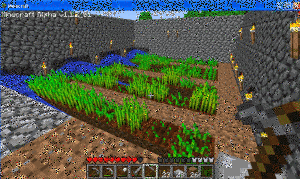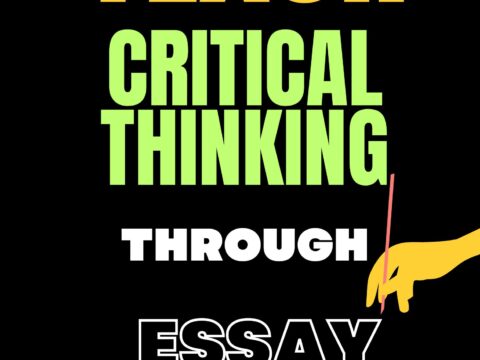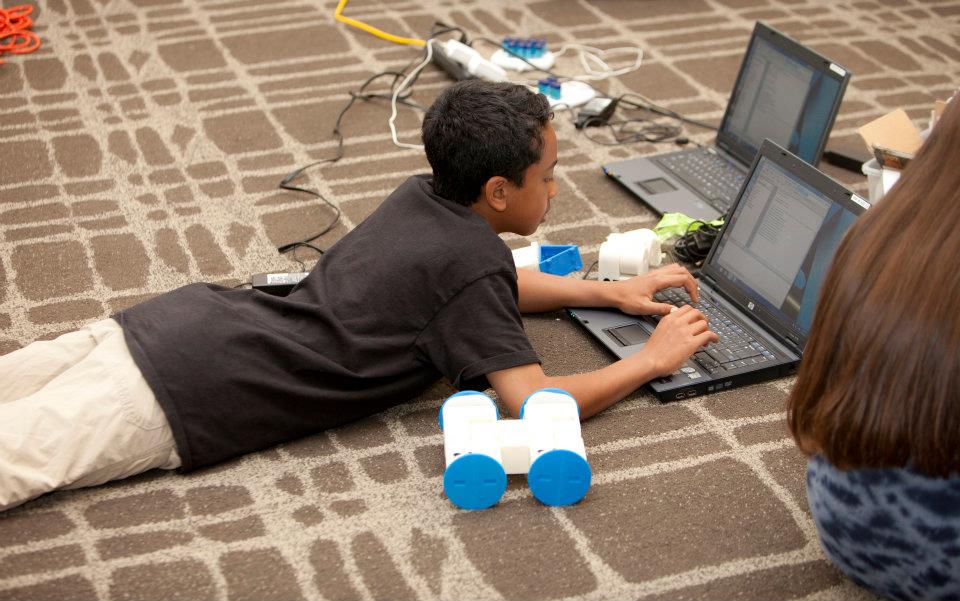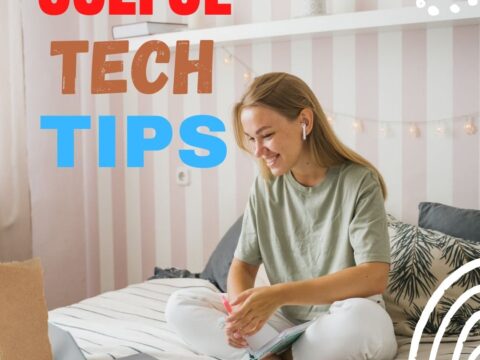 Last month, Scientific American declared “…“not only is Minecraft immersive and creative, but it is an excellent platform for making almost any subject area more engaging.” A nod from a top science magazine to the game many parents wish their kids had never heard of. This, following Common Sense Media’s seal of approval. On the surface, it’s not so surprising. Something like 80% of five-to-eight year-olds play games and 97% of teens. Early simulations like Reader Rabbit are still used in classrooms to drill reading and math skills.
Last month, Scientific American declared “…“not only is Minecraft immersive and creative, but it is an excellent platform for making almost any subject area more engaging.” A nod from a top science magazine to the game many parents wish their kids had never heard of. This, following Common Sense Media’s seal of approval. On the surface, it’s not so surprising. Something like 80% of five-to-eight year-olds play games and 97% of teens. Early simulations like Reader Rabbit are still used in classrooms to drill reading and math skills.
But Minecraft, a blocky retro role-playing simulation that’s more Lego than svelte hi-tech wizardry, isn’t just the game du jour. Kids would skip dinner to play it if parents allowed. Minecraft is role playing and so much more.
Let me back up a moment. Most simulation games–where players role-play life in a pretend world–aren’t so much Make Your Own Adventure as See If You Survive Ours. Players are a passenger in a hero’s journey, solving riddles, advancing through levels and unlocking prizes. That’s not Minecraft. Here, they create the world. Nothing happens without their decision–not surroundings or characters or buildings rising or holes being dug. There isn’t a right or wrong answer. There’s merely what You decide and where those decisions land You. Players have one goal: To survive. Prevail. They solve problems or cease to exist. If the teacher wants to use games to learn history, Minecraft won’t throw students into a fully fleshed simulation of the American Revolution. It’ll start with a plot of land and students will write the story, cast the characters, create the entire 1776 world. Again, think Legos.
And still, my students hang my picture in the Teacher Hall of Fame every time I let them play Minecraft–which I do regularly. Of course, I provide guidelines. Which they love. It’s fascinating that today’s game playing youth want a set of rules they must beat, parameters they must meet, levels (read: standards) they must achieve, and a Big Goal (think: graduation) they can only reach after a lot of hard work, intense thinking, and mountains of problems. Look into the eyes of a fifth grader who just solved the unsolvable–something most adults s/he knows can’t do. You’ll remember why you’re a teacher.
A note: Any time students use the internet, start with a discussion on how to use it safely. This is especially important with multi-player games like Minecraft (you will close the system at school, but that may not be the case in the student’s home). It is fairly easy for students to create their own servers (requires no hardware, just a bit of coding) and invite friends into their Minecraft world. Encourage this rather than entering an unknown server-world.
In case you must ‘sell’ this idea to your administration, here are three great reasons why students should use Minecraft in school: Reading, Writing, and Problem Solving.
Reading
Game playing develops reading skills. Games skip the grammar and punctuation that lots of students struggle with and concentrate on comprehension. The real reason we read is to learn, experience new adventures, find out what’s over the next horizon. The only reason few teachers use game-playing for reading comprehension is they haven’t thought of it. Allow me to change that. Let’s evaluate the Common Core Reading Standards and their good fit with games:
|
What Common Core Expects |
What Game Delivers |
| Close reading to determine what text says and make logical inferences | In most games, players can’t progress without this |
| Determination of central ideas | Required to understand the game’s big picture because few are based on common knowledge |
| Analysis of how and why individuals, events, ideas develop and interact | This is how players determine game mechanics |
| Interpretation of words and phrases | Many words are game-specific (domain-specific). Players figure out meaning while playing (in context) |
| Assessment of point of view and purpose to shape content and style | This is how players determine good guys from bad |
| Integration and evaluation of content | Games include clues players must decode to advance |
| Delineation and evaluation of specific claims, as well as relevance and sufficiency of evidence | Players must use their brains to solve problems. That’s fun. |
| Proficient comprehension of complex texts | Games like Minecraft are complex. That’s part of their appeal. Rarely does a player give up. |
Writing
In my classes, students must start Minecraft by answering a series of questions I pose. I give them ‘a few’ game sessions to come up with the following about the world they are creating:
- What is the story behind what you’re building? Minecraft doesn’t have a plot so the storyline must come from the players’ imagination. How students answer this question is always interesting.
- Who are the characters in your made-up world? Tell me stuff about them. What motivates them–what drives them to live in this world? Minecraft starts with only one character–the student. It’s up to him/her to find more. Often this comes from collaborating with fellow students.)
- What is the setting? The game starts as a natural setting fraught with hazards. What does the student add and why?
- What is the sequence of events the characters followed to reach wherever they are by the end of the session? This is the plot
- Discuss why you collaborated with others in surviving this world. What did they add to your success?
- Describe a new approach you used in your play that you haven’t used before. I want to see their creativity, critical thinking, and problem solving in action.
- Describe research you did to make your Minecraft world more realistic and workable. This might include geology, geography, chemistry, or another topic.
Do you see what I’m doing? I’m asking for exemplars of how Minecraft gamers used Common Core writing standards. Their answers can be verbal or delivered by a group, but they must be well-thought out, knowledgeable, and filled with evidence or they don’t get to play again. The surprising part is no one minds these questions. They love talking Minecraft with an adult who listens and is interested. We all have a great time.
Problem Solving
Because Minecraft is not story-based, everything that happens requires a decision on the player’s part. How well-thought out those decisions are affects what happens next. This is great motivation for critical thinking and problem solving.
Of all Minecraft’s educational strengths, this may be the greatest. Players start with nothing and must build their way to security, safety, food, shelter, companionship. What a primer in problem solving. I’ve found throughout my teaching career that the most effective lessons are those with real-world applications. Theory makes sense to only a few and scares the rest. Here, in a world students eagerly enter, are real problems they must solve that will make a difference in their life. When a settler’s wagon floods in Oregon Trail, players get another one. When they are attacked in Minecraft and have no where to hide because they haven’t built shelter, it ruins the player’s day.
That’s reality.
In case you’re not a Minecraft aficionado, I’ll let you in on a secret: There are no manuals. Players learn by doing, failing, trying again. Suddenly, Common Core Standards for Mathematical Practice take on a whole new importance:
|
What Math Standard Expects |
What Game Delivers |
| Make sense of problems and persevere in solving them | Students work to understand and solve problems within game constructs |
| Reason abstractly and quantitatively | To play effectively requires student understand what is occurring and visualize solutions. |
| Construct viable arguments and critique the reasoning of others | The game’s nature requires students interact with others to discern who can assist in achieving goals. |
| Model | Game models a reality students likely will never experience, but wish they could. |
| Use appropriate tools strategically | As with real life, players must determine what tools are available (both physical and psychological) and how to use them to achieve goals |
| Look for and make use of structure | Life in the game works better with a plan |
If you’re using Minecraft as a class activity, consider these best practices:
- Expect a learning curve and plan time for one. Some students won’t need it; others will.
- Have students work in groups. This helps non-gamers with mechanics.
- Be involved. Don’t let gamers intimidate you from observing and directing
- Set behavioral expectations. Your goals are different from typical game-play. Let students know what they are.
- Align goals with learning. Make this clear to students.
- Scaffold non-gamers with groups.
- Update parents consistently, They will wonder about using a game to learn reading and writing.
- Make failure fun. Game purpose isn’t to win; it’s to learn.
- Expect students to play in many locations. In fact, encourage that.
There you have it–how I use Minecraft to scaffold reading, writing, and problem solving. From this beginning, you’ll find unlimited applications. I have online efriends whose students use Minecraft to build molecules for a chemistry class, designs for 3D printing, and bridges for an 8th grade science project. Students quickly move beyond my list of questions to creating their own. We use Twitter as a shared resource, and students become Minecraft Tweeple, tweeting questions and answers using #hashtags. When they solve a prickly game problem, they type #problem with their name into our class Twitter stream and lay it out in 140 characters. That appears on the Smartscreen for everyone’s benefit.
One last point: I’m not going to kid you. Using Minecraft takes a commitment on the teacher’s part. It’s new. You’re breaking ground. You’ll have to talk yourself blue explaining to stakeholders why this is a good decision. You’ll put long hours in researching, studying, managing, and few will thank you.
But the kids will. And when they move on, they’ll remember that season with you, and how you taught them to think–I mean, let them play their favorite game.
***Image credit: Paulo Ordoveza
Jacqui Murray has been teaching K-18 technology for 30 years. She is the editor/author of over a hundred tech ed resources including a K-12 technology curriculum, K-8 keyboard curriculum, K-8 Digital Citizenship curriculum. She is an adjunct professor in tech ed, Master Teacher, webmaster for four blogs, an Amazon Vine Voice, CSTA presentation reviewer, freelance journalist on tech ed topics, contributor to NEA Today, and author of the tech thrillers, To Hunt a Sub and Twenty-four Days. You can find her resources at Structured Learning.




































Jacqui, I was working in a class yesterday and the students had been asked to re-tell a Maori creation myth. Two of the children have created stunning re-telings of these myths using Minecraft. The language was nuanced and deep and they clearly demonstrated a deep understanding of the myth and their direction and production of their retelling using Minecraft as a stage clearly reflected this.
I was deeply impressed at the quality of the learning, the language and the courage of the teacher to allow Minecraft to be used. I have asked the students and the teacher for permission to share this work with the wider world, but will have to wait to next term to find out the answer as we are just going into our term 1 break!
I’d love to share those videos with my readers. Let me know if you get the permissions. We are losing an opportunity considering Minecraft a ‘game’ and not an educational opportunity.
Add in Mineimator (Minecraft animation tool) and now you have a great digital storytelling platform!
David–I’m adding the link for Mineimator–http://www.stuffbydavid.com/mineimator. If you would prefer I don’t, let me know and I’ll remove. Looks like a great program. I’m also adding it to my Minecraft resource list.
Have you looked at MinecraftEDU? We run that version on local servers in summer camps and semester breaks. Kids in our sessions are in the same gamespace and begin to realize that real human kids are behind the avatars they interact with. Trollish behavior declines and we see the kids cooperate on building shopping malls, space craft, rollercoasters in theme parks, etc. That’s with using only a few of the features created for us in this version: http://minecraftedu.com/page/
Haven’t managed to persuade my school to use it, but I’ve heard good feedback on this version. Thanks for sharing your story. I’m developing my next attack!
I am all about using minecraft as a break time, but I am stoked about using it more to the common core and would love more resources.
Here are a few I’ve collected that might help you–https://askatechteacher.com/great-kids-websites/games/
http://minecrafthomeschool.com/ and http://whenyouriseup.com/skrafty-homeschool-minecraft-classes/ give some great ideas of how you can use minecraft for your educational goals. Thay have some very fun options available.
Good additions. Thanks, Sandy.